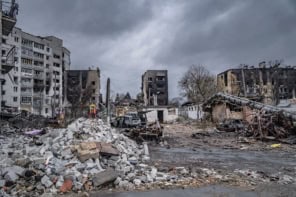
Fragments of fungal cells just 30 nm across have been found in the atmosphere at concentrations much higher than expected, according to experiments by researchers at the University of California, Irvine, US. These biological nanoparticles may play a role in cloud formation and could also trigger allergic reactions and asthma attacks.
Particles like soot and dust affect how clouds form by acting as “seeds” around which ice can nucleate or water can condense. Biological particles such as intact pollen and fungal spores can also make effective ice nuclei, but since these large particles are relatively uncommon in the atmosphere, scientists believe they are unlikely to play a significant role in ice-cloud formation under most conditions.
Now, however, Michael Lawler and colleagues, who are in James Smith’s group at UC Irvine, have detected smaller fungal particles being released during episodic bursts into the air over a rural area. The results, which were obtained at the Department of Energy’s Atmospheric Radiation Measurement (ARM) field site near Lamont, Oklahoma, showed that the concentrations of these fungal nanoparticles were orders of magnitude higher than large intact biological particles.
Size-selected nanoparticles
The team’s experiment involved drawing air into an instrument called a thermal desorption chemical ionization mass spectrometer. This instrument is size-selective, which meant the researchers could choose to sample only those nanoparticles measuring between 20 and 60 nm in diameter. They collected the particles onto a thin platinum filament, vaporized them by heating the filament and then detected the resulting gases.
Lawler and colleagues identified the fungal fragments by detecting chitin – the main component of fungal cell walls – and sugar alcohols such as mannitol, which the fungi use to store energy. Most of the particles they observed during their three-week measuring period were around 30 nm in size, and Lawler explains that some or all of them could make good cloud-condensation nuclei. However, he adds that more work is needed to test this hypothesis.
Allergies and asthma symptoms
During the detected fungal burst events, the concentrations of fungal nanoparticles increased from non-detectable levels (below perhaps 10 per cubic centimetre) to hundreds per cubic centimetre. Because particles smaller than 100 nm in diameter can be inhaled more deeply into the lungs, and are also more chemically active than larger particles, such bursts could have important health implications. “We know that fungal cells can cause allergies and asthma symptoms when they are released into the air,” Lawler says. “We have now essentially found fungal ‘shrapnel’ that likely contain the same irritants as larger particles, but which are more numerous.”
“We cannot unequivocally say from this study whether the fungal nanoparticles we detected could adversely affect health,” he continues, “but it seems possible that at least some of the health impacts associated with aerosol fungus could be caused by these smaller particles.”

Nanoparticles power up a storm
Rainfall and the appearance of fungal nanoparticles
As for the causes of the “bursts”, the researchers speculate that they might be prompted by raindrops hitting the soil in which the fungi are growing. In their work, which they report in Science Advances, they found that particle counts increased within roughly a day of rainfall at the field site, but Lawler cautions that they know little about the exact processes involved. Unanswered questions include whether the cells burst in the air or on the surface of the soil, and whether rain or merely an increase in relative humidity controls the generation of the nanoparticles.
Future studies should shed more light on the mechanisms behind the bursts, and the researchers also hope that more measurements will help pin down the ice-nucleating potential of fungal nanoparticles. A third avenue for follow-up work would be to identify the specific fungal species involved. “This will help us define the likely health impacts of these nanoparticles, how they are generated and under which conditions,” Lawler tells Physics World.



